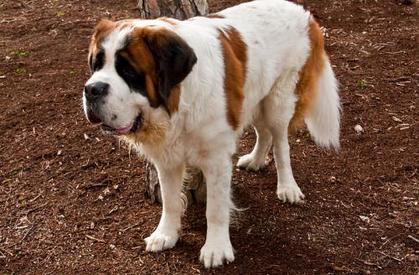
Falling within the Kennel Club's 'working' breed group, the St. Bernard has a decorated history, dating back to 980 AD. Established by St. Bernard de Menthon and bred by monks, the St. Bernard is most likely descended from the Great Dane, Greater Swiss Mountain Dog, Great Pyrenees and the Tibetan Mastiff. Originally bred as guardian dogs in the Great St. Bernard Hospice, a refuge for distressed wanderers in the Alpine Pass, the breed became a popular rescue dog, helping to find those trapped after an avalanche and return with a search party. It is commonly believed that the St. Bernard is an ancestor of molasser-type dogs, introduced to the Alps by the Romans centuries ago. Despite appearing in drawings and paintings from much earlier, the dog is first referenced in written records from 1707. Officially recognised by the American Kennel Club in 1885, the modern St. Bernard is commonly observed in guarding, search and rescue, and pulling carts.
Boasting a large, muscular build, with powerful legs, a short and broad muzzle, a low-set, heavily feathered tail, and large pendant ears. The St. Bernard of today differs greatly from the breed of old, possessing a longer coat that would have been historically unsuited to life in the Alps, freezing and thus weighing down the dog. The coat of today is typically dense, and either smooth and close-fitting or rough. Often described as a 'gentle giant,' the St. Bernard is characteristically benevolent, with a calm, companionable and easy-going temperament. Rumour has it that the St. Bernard can sense an impending avalanche by detecting low frequency sounds, not audible to the human ear.
As with any large-size breed, the St. Bernard should always be observed around children. Never unduly nervous or aggressive, the St Bernard makes an ideal companion dog, whether for a family or dedicated sole owner. Loyal and eager to please, the St. Bernard will fearlessly defend its family and home if potential threat is perceived, otherwise remaining docile, affectionate and engaged in active domestic life. On average, a healthy St. Bernard will weigh 50-90 kg with large discrepancies across gender, with a relatively short life expectancy of 8-10 years.
Although generally a healthy and resilient breed, the St. Bernard is susceptible to certain ailments, including hip dysplasia and associated orthopedic complaints, as well as several optical problems. Additionally, the breed is prone to various cancers and mast-cell tumours, as well as cardiac-related illnesses resulting from its large size.








From Sjælland, Denmark
Frigg is a bulldozer.
She loves children, but she knocks them over because of her size.
She has also laid our garden fence down a few times, just to come out and say hi to those pore people on the other side. LOL
She doesn’t know she’s a big girl and really wants to cuddle a lot.
I love her to pieces and don’t ever want another breed.
But if you want a clean house, don’t get a St. Bernard.